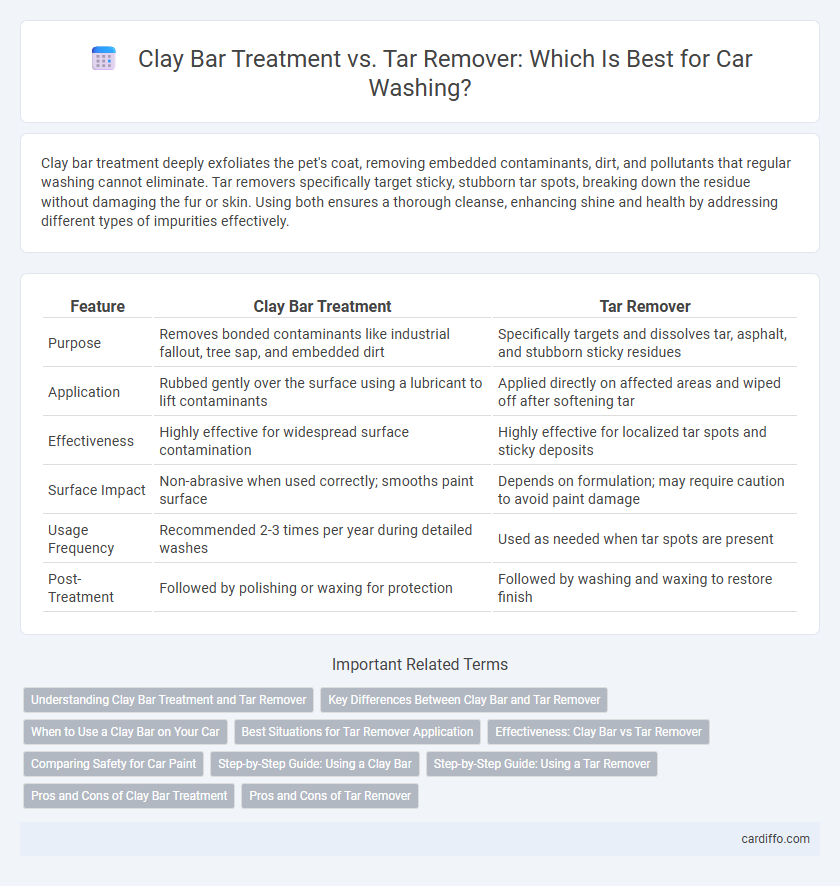Clay bar treatment deeply exfoliates the pet's coat, removing embedded contaminants, dirt, and pollutants that regular washing cannot eliminate. Tar removers specifically target sticky, stubborn tar spots, breaking down the residue without damaging the fur or skin. Using both ensures a thorough cleanse, enhancing shine and health by addressing different types of impurities effectively.
Table of Comparison
| Feature | Clay Bar Treatment | Tar Remover |
|---|---|---|
| Purpose | Removes bonded contaminants like industrial fallout, tree sap, and embedded dirt | Specifically targets and dissolves tar, asphalt, and stubborn sticky residues |
| Application | Rubbed gently over the surface using a lubricant to lift contaminants | Applied directly on affected areas and wiped off after softening tar |
| Effectiveness | Highly effective for widespread surface contamination | Highly effective for localized tar spots and sticky deposits |
| Surface Impact | Non-abrasive when used correctly; smooths paint surface | Depends on formulation; may require caution to avoid paint damage |
| Usage Frequency | Recommended 2-3 times per year during detailed washes | Used as needed when tar spots are present |
| Post-Treatment | Followed by polishing or waxing for protection | Followed by washing and waxing to restore finish |
Understanding Clay Bar Treatment and Tar Remover
Clay bar treatment effectively removes embedded contaminants such as industrial fallout, brake dust, and bonded pollutants from a vehicle's paint surface by gently lifting them away without damaging the clear coat. Tar remover specifically targets sticky, stubborn substances like road tar, sap, and asphalt that clay bars may struggle to dissolve, offering a chemical solution for these residues. Understanding the distinct functions of clay bars and tar removers enhances vehicle detailing by ensuring thorough decontamination and a smooth, clean finish.
Key Differences Between Clay Bar and Tar Remover
Clay bar treatment physically removes embedded contaminants like industrial fallout, tree sap, and brake dust from the surface of car paint by gently exfoliating the clear coat. Tar remover formulates specifically target and dissolve stubborn tar, asphalt, and bitumen spots without abrasion but may not eliminate other bonded contaminants effectively. While clay bars enhance surface smoothness and paint clarity through mechanical action, tar removers chemically dissolve sticky residues, making them complementary yet distinct products in automotive detailing.
When to Use a Clay Bar on Your Car
A clay bar is ideal when your car's paint surface feels rough or has embedded contaminants that cannot be removed through washing alone. Use a clay bar before applying wax or sealant to ensure a smooth, clean finish by removing bonded particles such as industrial fallout, brake dust, and tree sap. Tar remover is more suitable for localized sticky substances like tar spots, but a clay bar provides a more thorough decontamination of the entire paint surface.
Best Situations for Tar Remover Application
Tar remover is best applied on surfaces heavily contaminated with stubborn tar spots, road grime, and industrial fallout where clay bars may struggle to effectively lift the residue. It penetrates and dissolves adhesive substances quickly, making it ideal for early-stage paint correction before a wash or polish. Using tar remover ensures a cleaner surface, reducing the risk of scratches during subsequent clay bar treatment.
Effectiveness: Clay Bar vs Tar Remover
Clay bar treatment effectively removes bonded surface contaminants like overspray, industrial fallout, and tree sap, restoring smoothness and enhancing paint clarity. Tar remover specifically targets and dissolves stubborn tar spots and asphalt residues that a clay bar may not fully eliminate. Combining both treatments ensures comprehensive contaminant removal for optimal vehicle surface cleanliness and protection.
Comparing Safety for Car Paint
Clay bar treatment delicately removes contaminants like industrial fallout and tree sap without damaging the clear coat, making it safer for car paint when used properly. Tar remover specifically targets stubborn tar and asphalt deposits but can contain harsher solvents that may risk damaging delicate paint surfaces if over-applied. Opting for a clay bar treatment ensures a gentler, more controlled cleaning process, minimizing the chance of paint etching or dulling compared to chemical tar removers.
Step-by-Step Guide: Using a Clay Bar
Using a clay bar involves thoroughly washing the vehicle, then drying it completely to ensure the surface is free of loose dirt. Gently glide the clay bar over the lubricated paint surface using a dedicated detailing spray, working in small sections to remove embedded contaminants. Rinse and wipe off residue frequently to maintain a smooth finish before moving on to the next area or applying wax.
Step-by-Step Guide: Using a Tar Remover
Apply the tar remover directly to affected areas on a cool, dry surface, allowing it to penetrate for 3-5 minutes without drying out. Use a microfiber cloth or soft brush to gently agitate and lift tar deposits, ensuring minimal risk to paint finish. Rinse thoroughly with water, then follow up with a clay bar treatment to remove any remaining contaminants and restore the smooth surface.
Pros and Cons of Clay Bar Treatment
Clay bar treatment effectively removes embedded contaminants like brake dust, industrial fallout, and tree sap, restoring a smooth vehicle surface. It can be time-consuming and requires proper technique to avoid paint marring or surface scratching. Unlike tar removers, clay bars do not dissolve tar but excel at eliminating finer particles and improving paint clarity.
Pros and Cons of Tar Remover
Tar remover effectively dissolves stubborn tar and asphalt without excessive abrasion, making it ideal for restoring vehicle surfaces quickly. It can sometimes strip wax or sealant if not used carefully, requiring post-treatment protection to maintain shine. Its targeted formula outperforms clay bars in removing embedded tar but lacks the clay bar's versatility in eliminating general contaminants.
clay bar treatment vs tar remover Infographic

 cardiffo.com
cardiffo.com